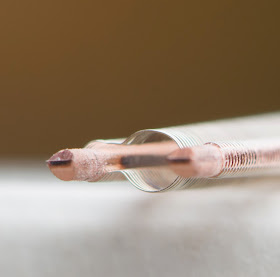Last month I showed the 6GE5 compactron beam pentode and mentioned it's usability as an output tube in a single ended amp. I went through the compactron series tubes to find a suitable driver. And this is what I found: The 6AG9
Since I have a preference for all triode amps, I concentrated on triodes only. There are quite a few of them in the compactron series. Some combined with other triodes, diodes or pentodes in one bottle.
 The 6AG9 contains a triode and a pentode. The triode section has an amplification factor of 39 and a plate resistance of 8500 Ohm. Quite similar to the values of the 6N7 which I like to use as driver for small output tubes. This would make it usable in a 2 stage amp with transformer-, LC or RC coupling. The heater current is a bit on the high side for such a triode, but that is because it also needs to supply the heater of the pentode section. A quick glance into the data sheet shows some nice plate curves of the triode section. A check of prices showed a nicely low cost of $3-4 for the tube. It seems to be an ideal companion for the 6GE5! These are the plate curves as shown in the data sheet:
The 6AG9 contains a triode and a pentode. The triode section has an amplification factor of 39 and a plate resistance of 8500 Ohm. Quite similar to the values of the 6N7 which I like to use as driver for small output tubes. This would make it usable in a 2 stage amp with transformer-, LC or RC coupling. The heater current is a bit on the high side for such a triode, but that is because it also needs to supply the heater of the pentode section. A quick glance into the data sheet shows some nice plate curves of the triode section. A check of prices showed a nicely low cost of $3-4 for the tube. It seems to be an ideal companion for the 6GE5! These are the plate curves as shown in the data sheet:And this is how it looks like in real life:
Quite alright if the region to the left is avoided!
Most 6AG9s in my stock came unmarked in bulk pack like those above.
Here a 6AG9 mage by General Electric:
The 12-Pin base:
Let's have a look how it is constructed inside!
Removing the glass reveals a better view of the details:
The pentode section takes up most of the space inside. The triode section (top) is separated by some space and a screen from the pentode (silver sheet of metal).
A view of the side of the pentode section:
The top:
The heater wire can be nicely seen coming out of the top and connecting across the tube between the sections.
The heater wire removed:
The part with more folds heats the pentode.
The triode section:
The triode electrodes separated:
The grid:
Cathode:
The triode grid is circular shaped:
The shield which separates triode and pentode:
The pentode section, cathode, control grid and screen grid on the left, plate and suppressor grid on the right:
The grids separated from the cathode:
The control grid has an extremely fine pitch between the wires:
A very well made tube, completely overlooked by audio designers!
In the meantime the tube serves as driver in a 6GE5 amp. Stay tuned for a report.
Best regards
Thomas


























Happy Holidays Thomas! Have you had a chance to directly compare the 6AG9 to the 6N7, driving a DHT? The round grid structure and precision is interesting. Lower plate resistance can't hurt either.
ReplyDeleteBest, Jason
No, never did a direct comparison. Too many projects ongoing, no time of such things ;-)
DeleteHappy holidays to you too
It occurs to me that this might make a good sounding single bottle mm phono stage using a topology similiar to your octal phono stage. What do you think?
ReplyDeleteThe Octal phono uses two triode sections. The tube has a triode and a pentode. I haven't looked into usage for a phono with this. If you have a specific circuit in mind to utilise the pentode section as well why don't you try it on a bread board?
DeleteWhat I meant was using the triode section as the input tube, then a passive RIAA network, then a triode connected pentode output. I would breadboard it but Im not knowledgeable enough to design it or select the operating points for this application. Really I was just curious if you the thought the tube had the potential for being used this way? If there was anything about that would disqualify it as a phono tube for some reason. Thanks for your response.
DeleteI never characterised the pentode section in triode mode. So can't really say.
Delete